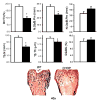CCAAT/Enhancer-binding protein homologous protein (CHOP) decreases bone formation and causes osteopenia
- PMID: 17095306
- PMCID: PMC1850334
- DOI: 10.1016/j.bone.2006.09.028
CCAAT/Enhancer-binding protein homologous protein (CHOP) decreases bone formation and causes osteopenia
Abstract
CCAAT enhancer-binding protein (C/EBP) homologous protein (CHOP), is a member of the C/EBP family of nuclear proteins and plays a role in osteoblastic and adipocytic cell differentiation. CHOP is necessary for normal bone formation, but the consequences of its overexpression in vivo are not known. To investigate the direct actions of CHOP on bone remodeling in vivo, we generated transgenic mice overexpressing CHOP under the control of the human osteocalcin promoter. CHOP transgenics exhibited normal weight and reduced bone mineral density. Static and dynamic femoral bone histomorphometry revealed that CHOP overexpression caused reduced trabecular bone volume, secondary to decreased bone formation rates. One of 2 lines displayed a decrease in the number of osteoblasts, but in vivo bromodeoxyuridine labeling demonstrated that CHOP overexpression did not have an effect on osteoblastic cell replication. The decreased osteoblast cell number was accounted by an increase in apoptosis, as determined by DNA fragmentation measured by transferase-mediated digoxigenin-deoxyuridine triphosphate (dUTP) in situ nick-end labeling (TUNEL) reaction. In conclusion, transgenic mice overexpressing CHOP in the bone microenvironment have impaired osteoblastic function leading to osteopenia.
Figures





References
-
- Hanson RW. Biological role of the isoforms of C/EBP minireview series. J Biol Chem. 1998;273:28543. - PubMed
-
- Park JS, Luethy JD, Wang MG, Fargnoli J, Fornace AJ, Jr, McBride OW, Holbrook NJ. Isolation, characterization and chromosomal localization of the human GADD153 gene. Gene. 1992;116:259–67. - PubMed
-
- Ron D, Habener JF. CHOP, a novel developmentally regulated nuclear protein that dimerizes with transcription factors C/EBP and LAP and functions as a dominant-negative inhibitor of gene transcription. Genes Dev. 1992;6:439–53. - PubMed
Publication types
MeSH terms
Substances
Grants and funding
LinkOut - more resources
Full Text Sources
Molecular Biology Databases
Research Materials

